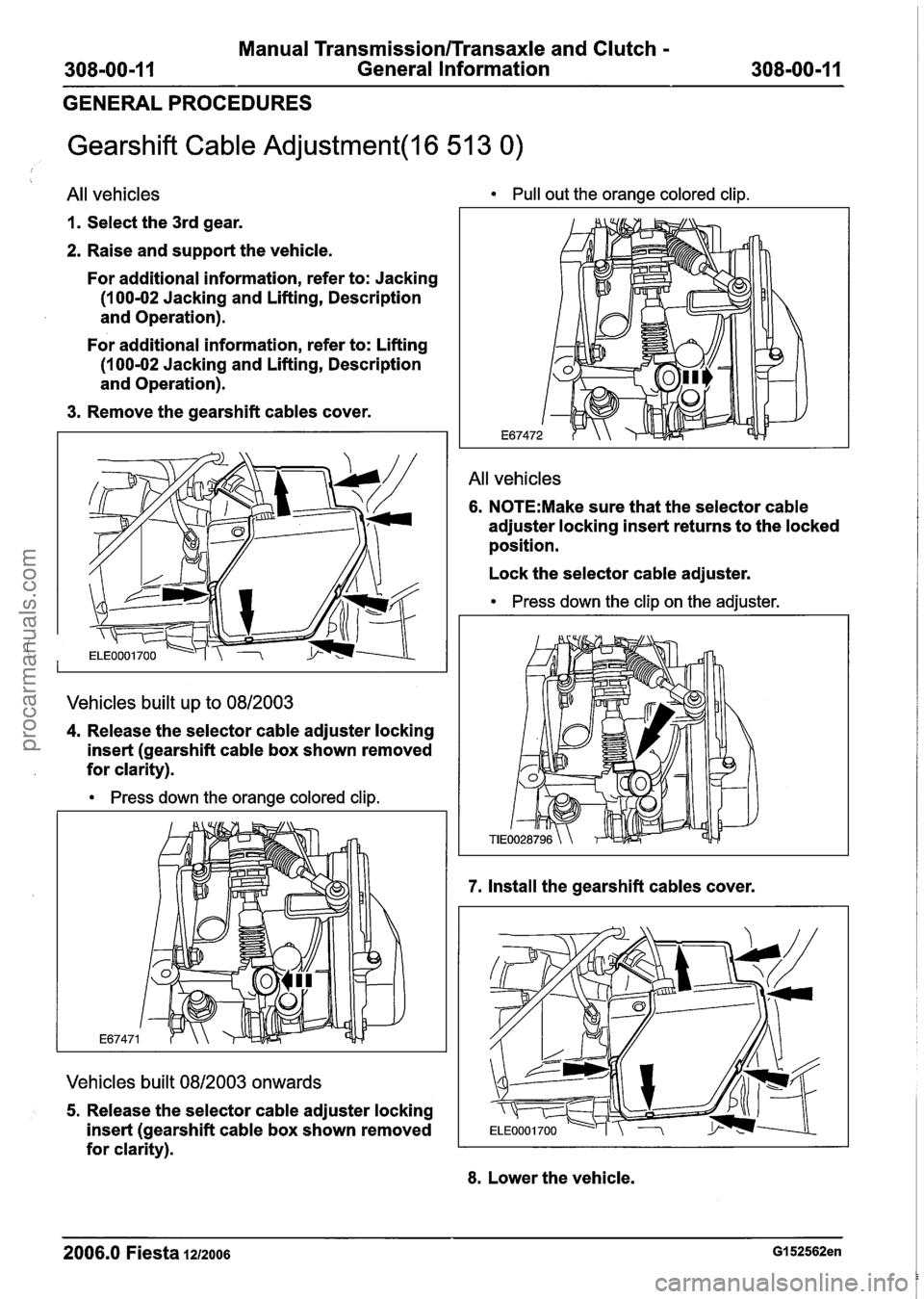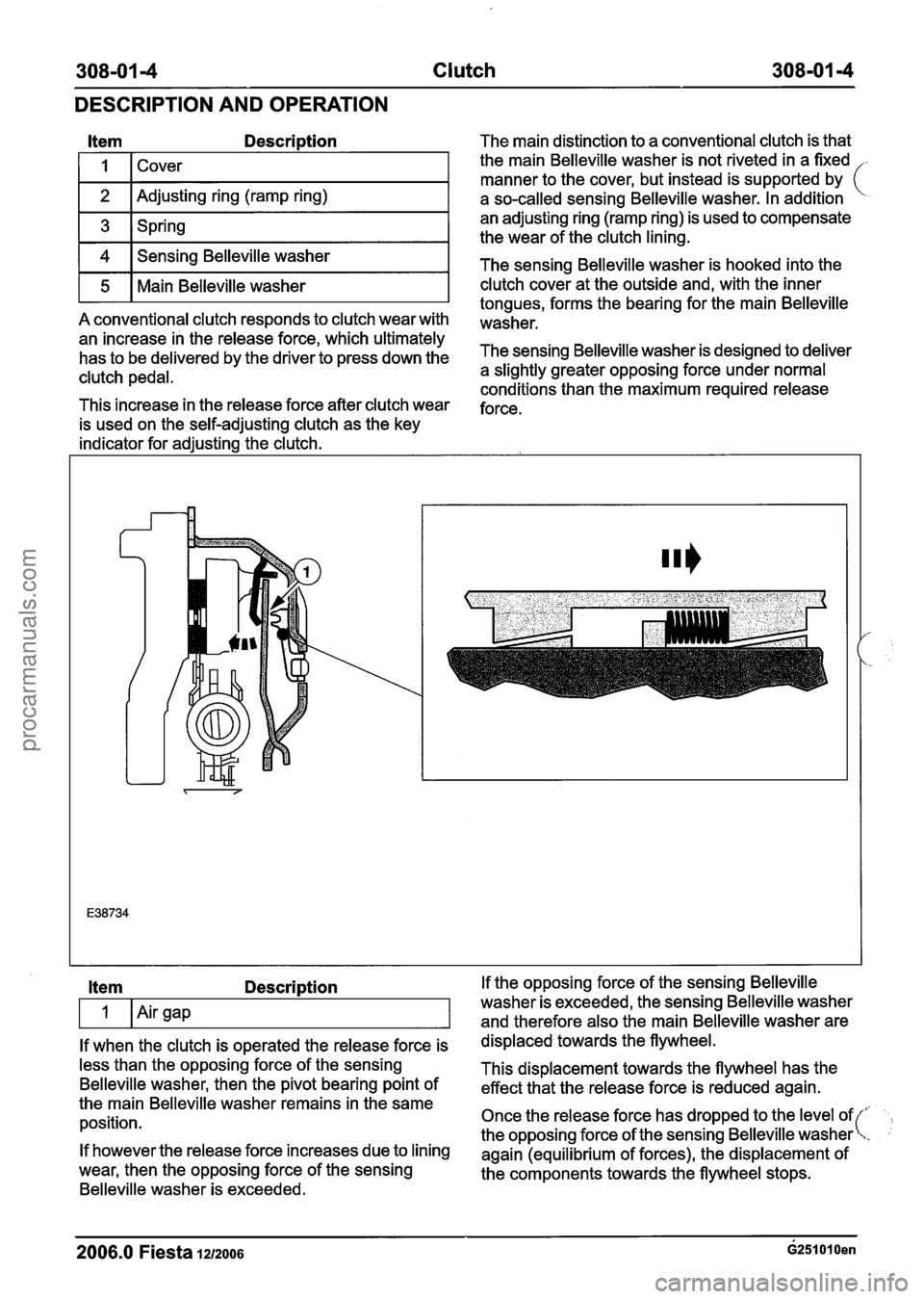Page 1069 of 1226

Manual Transmission/Transaxle and Clutch -
308-00-1 1 General Information 308-00-1 I
GENERAL PROCEDURES
Gearshift Cable Adjustment(l6 51 3 0)
All vehicles
1. Select the 3rd gear.
2. Raise and support the vehicle.
For additional information, refer to: Jacking
(1
00-02 Jacking and Lifting, Description
and Operation).
For additional information, refer to: Lifting
(1
00-02 Jacking and Lifting, Description
and Operation).
3. Remove the gearshift cables cover.
Vehicles built up to 0812003
4. Release the selector cable adjuster locking
insert (gearshift cable box shown removed
for clarity).
Press down the orange colored clip.
Vehicles built 0812003 onwards
5. Release the selector cable adjuster locking
insert (gearshift cable box shown removed
for clarity).
Pull out the orange colored clip.
All vehicles
6. N0TE:Make sure that the selector cable
adjuster locking insert returns to the locked
position.
Lock the selector cable adjuster.
Press down the clip on the adjuster.
7. Install the gearshift cables cover.
8. Lower the vehicle.
2006.0 Fiesta 1212006 GI 52562en
procarmanuals.com
Page 1070 of 1226

Manual Transmission/Transaxle and Clutch -
308-00-1 2 General Information 308-00-1 2
GENERAL PROCEDURES
Clutch System Bleeding(l6 843 0)
Special Tool(s) 6. Fill the reservoir of the special tool with (,, .
I Hand Vacuum approximately 100 ml of new brake fluid.
7. N0TE:Make sure that the special tool
reservoir is positioned lower than the bleed
nipple.
Install the special tool.
Super DOT 4 Brake
1 Fluid
I
Materials
Name Specification
ESD-M6C57-A
A WARNING: Brake fluid contains polyglycol
ethers and polyglycols. Avoid contact with
the eyes. Wash hands thoroughly after
handling. If brake fluid contacts the eyes,
flush the eyes for 15 minutes with cold
running water. Get medical attention if
irritation persists. If taken internally, drink
8. Using the special tool, bleed the clutch
water and induce vomiting. Get medical system.
attention immediately. Failure to follow
Pump approximately 80 ml of brake fluid into
these instructions may result in personal the clutch svstem. (
injury. w
9. Close the bleed nipple. A CAUTI0N:Y brake fluid is spilt on the
paintwork, the affected area must be 10.
Remove the special tool.
immediately washed down with cold water.
11. Lower the vehicle, if necessary.
N0TE:lf proprietary brake bleeding equipment is
available, this can be used to bleed the clutch
system, following the method below. The maximum
pressure must not exceed
1.5 bar.
N0TE:The clutch control system is self-venting.
The components are arranged in such a way that
small amounts of air trapped in the system are
removed automatically during clutch operation.
12. In order to remove any small amounts of
trapped air remaining in the system,
operate the clutch pedal several times
(maximum five times), using the full clutch
pedal travel.
13. Check the fluid level in the brake fluid
reservoir and top up to the MAX mark with
brake fluid if necessary.
1. Remove the air cleaner, if necessaryfor 14. Install the battery tray, if necessary.
additional information, refer to
Section
303-12 [Intake Air Distribution and 15.
Install the battery, if necessary. For
Filtering]. additional
information, refer to
Section 414-01 [Battery, Mounting and
2. Remove the battery, if necessary. For
Cablesl.
additional information, refer to
Section
414-01 [Battery, Mounting and . 16. Install the air cleaner, if necessary. For
Cables]. additional
information, refer to
Section 303-1
2 [Intake Air Distribution and - 3. Remove the battery tray, if necessary.
Filtering]. (' L 4. Drain the brake fluid reservoir.
17. Test the clutch control system for normal "I-
5. Raise and support the vehicle, if necessary. operation.
For additional information, refer to
Section 100-02 [Jacking and Lifting].
2006.0 Fiesta 1212006 GI 83752en
procarmanuals.com
Page 1071 of 1226
Manual Transmission/Transaxle and Clutch -
308-00-1 3 General Information 308-00-1 3
GENERAL PROCEDURES
Start the engine, depress the clutch pedal,
wait two seconds, then carefully engage
reverse gear. If there are any abnormal
noises, or reverse gear is difficult to engage,
repeat the clutch system bleeding procedure.
18. Initialize the door window motors, if
necessary. For additional information, refer
to Section 501-11 [Glass, Frames and
Mechanisms].
2006.0 Fiesta 1212006 GI 83752en
procarmanuals.com
Page 1073 of 1226
308-01 -1 Clutch 308-01 -1
SECTION 308-01 Clutch
VEHICLE APPLICATION:2006.0 Fiesta
CONTENTS PAGE
SPECIFICATIONS
Specifications.. ........................................................................\
...................................... 308-0 1 -2
DESCRIPTION AND
OPERATION
Clutch.. ........................................................................\
........................................................ 308-0 1 -3
........................................................................\
................................. Self-adjusting clutch.. 308-01 -3
DIAGNOSIS AND TESTING
Clutch.. ........................................................................\
........................................................ 308-01 -6
REMOVAL AND INSTALLATION
Clutch Disc and Pressure Plate .................................................................... (1 6 724 4) 308-0 1 -7
procarmanuals.com
Page 1074 of 1226
308-01 -2 Clutch 308-01 -2.
SPECIFICATIONS
Torque Specifications
I:. :
Item
Clutch pressure plate retaining bolts
2006.0 Fiesta 1212006 GI1 31 95en
Nm
29
I b-ft
21
Ib-in
-
procarmanuals.com
Page 1075 of 1226
308-01 -3 Clutch 308-01 -3
DESCRIPTION AND OPERATION
Clutch
Self-adjusting clutch Item Description
Advantages of the self-adjusting clutch
kern Descri~tion
I A I Release force in kN I
The self-adjusting clutch has the following
advantages over conventionally designed clutches:
lower release forces, which remain constant
over the service life and thus ensure high driving
comfort throughout the entire service life
increased wear reserve and therefore greater
service life due to the automatic wear
adjustment
/ i, ' Function
B
2006.0 Fiesta 1212006 G251010en
Release travel in mm
procarmanuals.com
Page 1076 of 1226

308-01 4 Clutch 308-01 -4
DESCRIPTION AND OPERATION
Item Description
I I 1 Cover I
1 2 I Adjusting ring (ramp ring) I
1 3 1 Spring I
1 4 1 Sensing Belleville washer I
r5 1 Main Belleville washer I
A conventional clutch responds to clutch wear with
an increase in the release force, which ultimately
has to be delivered by the driver to press down the
clutch pedal.
This increase in the release force after clutch wear
is used on the self-adjusting clutch as the key
indicator for adjusting the clutch. The main
distinction to a conventional clutch is that
the main Belleville washer is not riveted in a fixed
-
manner to the cover, but instead is supported by (
a so-called sensing Belleville washer. In addition
an adjusting ring (ramp ring) is used to compensate
the wear of the clutch lining.
The sensing Belleville washer is hooked into the
clutch cover at the outside and, with the inner
tongues, forms the bearing for the main Belleville
washer.
The sensing Belleville washer is designed to deliver
a slightly greater opposing force under normal
conditions than the maximum required release
force.
Item Description
If when the clutch is operated the release force is
less than the opposing force of the sensing
Belleville washer, then the pivot bearing point of
the main Belleville washer remains in the same
position.
If however the release force increases due to lining
wear, then the opposing force of the sensing
Belleville washer is exceeded. If the
opposing force of the sensing Belleville
washer is exceeded, the sensing Belleville washer
and therefore also the main Belleville washer are
displaced towards the flywheel.
This displacement towards the flywheel has the
effect that the release force is reduced again.
Once the release force has dropped to the level of
the opposing force of the sensing Belleville washer
again (equilibrium of forces), the displacement of
the components towards the flywheel stops.
2006.0 Fiesta lazoos ~251010en
procarmanuals.com
Page 1077 of 1226
308-01 -5 Clutch 308-01 -5
DESCRIPTION AND OPERATION
When the sensing Belleville washer is displaced
this results in an air gap between the main
i Belleville washer and the clutch cover.
The adjusting ring (ramp ring) arranged around the
circumference immediately compensates for the
air gap. To do this, springs press the adjusting ring
and therefore the ramp against the main Belleville
washer.
This results in a balancing of the clutch actuation
mechanism, which keeps the forces required to
operate the clutch constant throughout the entire
service life of the clutch.
2006.0 Fiesta 1212006 G251010en
procarmanuals.com